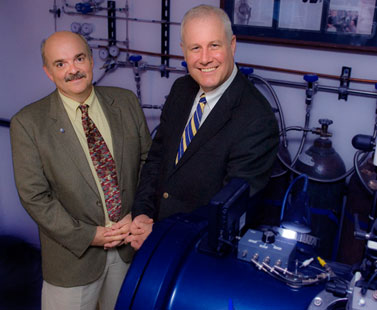Space neuroscience research: Astronaut-physician visits USF

Astronaut-physician Dr. Jay Buckey Jr, right, toured the Hyperbaric laboratory of USF Health’s Dr. Jay Dean during a visit here May 6. Dr. Buckey was a payload specialist for the Neurolab Space Mission, which provided an indepth look at how a basic natural force, gravity, can profoundly affect the nervous system.
Physician-astronaut Jay C. Buckey Jr., MD, visited the USF College of Medicine May 6 and spoke about his experiences as a payload specialist aboard the NASA space shuttle Columbia.
As a crew member for the 16-day Neuro lab flight, April 17 to May 3, 1998, he was a subject and operator for life science experiments focusing on the effects of microgravity on the brain and nervous system. The team evaluated the effects of weightlessness on balance, sensory integration and navigation, nervous system development, blood pressure control and circadian rhythms and sleep.
Among the experiments: monitoring eye movements of astronauts while they sat in a spinning chair; trying to catch a ball, which falls at a constant speed in space rather than accelerating as it drops; and investigating whether the balance systems of young lab rats learning to walk would develop normally without gravity. While more research is needed, “gravity certainly plays an important role in how the brain and nervous system develop,” said Dr. Buckey, who still consults with NASA and is now a professor of medicine and medical director of Hyperbaric Medicine at Dartmouth-Hitchcock Medical Center.
The findings from neuroscience research in space may have applications for patients who experience balance problems and provide insight into the brain’s ability to adapt and repair itself, he said.
In addition to discussing scientific results of the neuroscience space mission and showing video highlights, Dr. Buckey shared some personal insights about the ride of his life.
“Like 40 Corvettes revving at once” is how he has described the sound of the main engines snarling to life as he awaited launch. Once the space shuttle clears the launch tower, he said, it travels faster than the speed of sound within 55 seconds.
“In space, weightlessness is great fun. With the touch of a finger you can push yourself wherever you want to go,” he said.
Once the payload doors were open to reveal earth from afar, the view was “stunningly beautiful,” Dr. Buckey said. “You can watch lightning as it dances across the clouds and see different patterns in the water… We had a sunrise and sunset every 45 minutes.”
When the mission ended and the astronauts returned to earth, it took a day or two for their bodies to readjust to gravity. The inch-and-a-half in height Dr. Buckey gained in space — “no gravity was compressing the spine, so we all got a little taller” — disappeared once he was earthbound.
He added that being part of the space lab mission was “the perfect mix of adventure and scientific discovery.”
Dr. Buckey has written the book Space Physiology (2006) and co-edited The Neurolab Spacelab Mission: Neuroscience Research in Space (2002), which details the findings of the Neurolab space studies.
He was invited to USF Health by Jay Dean, PhD, professor of molecular pharmacology and physiology. At the College of Medicine, Dr. Dean directs the one of the country’s leading hyperbaric cell biology laboratories, where researchers are probing the health effects of too much oxygen on the central nervous system.
– Story by Anne DeLotto Baier, USF Health Communications
– Photo by Eric Younghans, USF Health Communications

